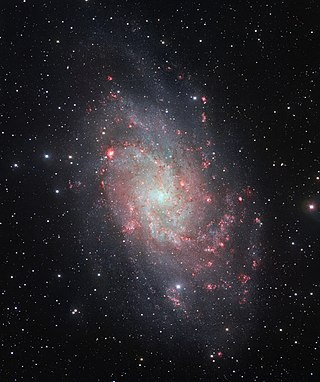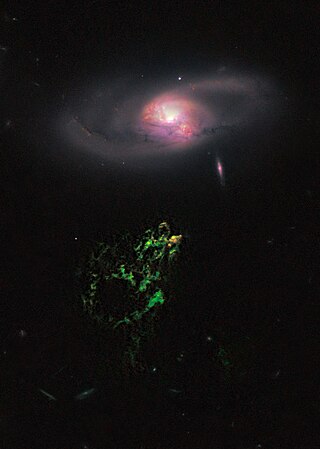Related Research Articles
The study of galaxy formation and evolution is concerned with the processes that formed a heterogeneous universe from a homogeneous beginning, the formation of the first galaxies, the way galaxies change over time, and the processes that have generated the variety of structures observed in nearby galaxies. Galaxy formation is hypothesized to occur from structure formation theories, as a result of tiny quantum fluctuations in the aftermath of the Big Bang. The simplest model in general agreement with observed phenomena is the Lambda-CDM model—that is, that clustering and merging allows galaxies to accumulate mass, determining both their shape and structure. Hydrodynamics simulation, which simulates both baryons and dark matter, is widely used to study galaxy formation and evolution.
An active galactic nucleus (AGN) is a compact region at the center of a galaxy that emits a significant amount of energy across the electromagnetic spectrum, with characteristics indicating that this luminosity is not produced by the stars. Such excess, non-stellar emissions have been observed in the radio, microwave, infrared, optical, ultra-violet, X-ray and gamma ray wavebands. A galaxy hosting an AGN is called an active galaxy. The non-stellar radiation from an AGN is theorized to result from the accretion of matter by a supermassive black hole at the center of its host galaxy.

The Triangulum Galaxy is a spiral galaxy 2.73 million light-years (ly) from Earth in the constellation Triangulum. It is catalogued as Messier 33 or NGC (New General Catalogue) 598. With the D25 isophotal diameter of 18.74 kiloparsecs (61,100 light-years), the Triangulum Galaxy is the third-largest member of the Local Group of galaxies, behind the Andromeda Galaxy and the Milky Way.

An elliptical galaxy is a type of galaxy with an approximately ellipsoidal shape and a smooth, nearly featureless image. They are one of the four main classes of galaxy described by Edwin Hubble in his Hubble sequence and 1936 work The Realm of the Nebulae, along with spiral and lenticular galaxies. Elliptical (E) galaxies are, together with lenticular galaxies (S0) with their large-scale disks, and ES galaxies with their intermediate scale disks, a subset of the "early-type" galaxy population.

A supermassive black hole is the largest type of black hole, with its mass being on the order of hundreds of thousands, or millions to billions, of times the mass of the Sun (M☉). Black holes are a class of astronomical objects that have undergone gravitational collapse, leaving behind spheroidal regions of space from which nothing can escape, including light. Observational evidence indicates that almost every large galaxy has a supermassive black hole at its center. For example, the Milky Way galaxy has a supermassive black hole at its center, corresponding to the radio source Sagittarius A*. Accretion of interstellar gas onto supermassive black holes is the process responsible for powering active galactic nuclei (AGNs) and quasars.

Christopher John Lintott is a British astrophysicist, author and broadcaster. He is a Professor of Astrophysics in the Department of Physics at the University of Oxford, and since 2023 is the Gresham Professor of Astronomy at Gresham College, London. Lintott is involved in a number of popular science projects aimed at bringing astronomy to a wider audience and is also the primary presenter of the BBC television series The Sky at Night, having previously been co-presenter with Patrick Moore until Moore's death in 2012. He co-authored Bang! – The Complete History of the Universe and The Cosmic Tourist with Moore and Queen guitarist and astrophysicist Brian May.

Galaxy Zoo is a crowdsourced astronomy project which invites people to assist in the morphological classification of large numbers of galaxies. It is an example of citizen science as it enlists the help of members of the public to help in scientific research.

The galaxy color–magnitude diagram shows the relationship between absolute magnitude and mass of galaxies. A preliminary description of the three areas of this diagram was made in 2003 by Eric F. Bell et al. from the COMBO-17 survey that clarified the bimodal distribution of red and blue galaxies as seen in the analysis of Sloan Digital Sky Survey data and even in de Vaucouleurs's 1961 analyses of galaxy morphology.

Hanny's Voorwerp, is a type of astronomical object called a quasar ionization echo. It was discovered in 2007 by Dutch schoolteacher Hanny van Arkel while she was participating as a volunteer in the Galaxy Zoo project, part of the Zooniverse group of citizen science websites. Photographically, it appears as a bright blob close to spiral galaxy IC 2497 in the constellation Leo Minor.

A Pea galaxy, also referred to as a Pea or Green Pea, might be a type of luminous blue compact galaxy that is undergoing very high rates of star formation. Pea galaxies are so-named because of their small size and greenish appearance in the images taken by the Sloan Digital Sky Survey (SDSS).

Green bean galaxies (GBGs) are very rare astronomical objects that are thought to be quasar ionization echos. They were discovered by Mischa Schirmer and colleagues R. Diaz, K. Holhjem, N.A. Levenson, and C. Winge. The authors report the discovery of a sample of Seyfert-2 galaxies with ultra-luminous galaxy-wide narrow-line regions (NLRs) at redshifts z=0.2-0.6.
Red nuggets is the nickname given to rare, unusually small galaxies packed with large amounts of red stars that were originally observed by Hubble Space Telescope in 2005 in the young universe. They are ancient remnants of the first massive galaxies. The environments of red nuggets are usually consistent with the general elliptical galaxy population. Most red nuggets have merged with other galaxies, but some managed to stay unscathed.

NGC 708 is an elliptical galaxy located 240 million light-years away in the constellation Andromeda and was discovered by astronomer William Herschel on September 21, 1786. It is classified as a cD galaxy and is the brightest member of Abell 262. NGC 708 is a weak FR I radio galaxy and is also classified as a type 2 Seyfert galaxy.

NGC 3489 is a lenticular galaxy located in the constellation Leo. It is located at a distance of about 30 million light years from Earth, which, given its apparent dimensions, means that NGC 3489 is about 30,000 light years across. It was discovered by William Herschel on April 8, 1784. NGC 3489 is a member of the Leo Group.

NGC 1386 is a spiral galaxy located in the constellation Eridanus. It is located at a distance of circa 53 million light years from Earth, which, given its apparent dimensions, means that NGC 1386 is about 50,000 light years across. It is a Seyfert galaxy, the only one in Fornax Cluster.

The Teacup galaxy, also known as the Teacup AGN or SDSS J1430+1339 is a low redshift type 2 quasar, showing an extended loop of ionized gas resembling a handle of a teacup, which was discovered by volunteers of the Galaxy Zoo project and labeled as a Voorwerpje.

Rebecca Smethurst, also known as Dr. Becky, is a British astrophysicist, author, and YouTuber who is a junior research fellow at the University of Oxford. She was the recipient of the 2020 Caroline Herschel Prize Lectureship, awarded by the Royal Astronomical Society, as well as the 2020 Mary Somerville Medal and Prize, awarded by the Institute of Physics. In 2022, she won the Royal Astronomical Society's Winton Award "for research by a post-doctoral fellow in Astronomy whose career has shown the most promising development".

Gems of the Galaxy Zoos (Zoogems) was a gap-filler project which used the Hubble Space Telescope to take images of unusual objects found by volunteers classifying data from both Galaxy Zoo (GZ) and Radio Galaxy Zoo (RGZ). Between the HSTs' main observations, there is a short time that objects within that field of view can be imaged using gaps which last approximately 12 - 25 mins. The Zoogems project sought to use those small observation gaps to image 300 candidates taken from the two Zoos in order to better study and comprehend them. Starting observations in May 2018, HST Proposal 15445 had by the end of September 2023 imaged 193 of the 300 candidates with many of them having near 11 minute exposures.

Grant Tremblay is an American astrophysicist notable for research on supermassive black holes, science communication, and public advocacy for large space telescopes. He is currently an Astrophysicist at the Harvard-Smithsonian Center for Astrophysics, and was formerly a NASA Einstein Fellow at Yale University, a Fellow at the European Southern Observatory (ESO), and an Astronomer at ESO's Very Large Telescope (VLT).
References
Schawinski, Kevin; Urry, C. Megan; Simmons, Brooke D.; Fortson, Lucy; Kaviraj, Sugata; Keel, William C.; Lintott, Chris J.; Masters, Karen L.; Nichol, Robert C.; Sarzi, Marc; Skibba, Ramin (2014-05-01). "The green valley is a red herring: Galaxy Zoo reveals two evolutionary pathways towards quenching of star formation in early- and late-type galaxies". Monthly Notices of the Royal Astronomical Society. 440 (1): 889–907. arXiv: 1402.4814 . Bibcode:2014MNRAS.440..889S. doi: 10.1093/mnras/stu327 . ISSN 0035-8711.
- ↑ Williams, Matt (24 December 2015). "Nebulae: What Are They And Where Do They Come From?". UniverseToday. Retrieved 16 January 2023.
- ↑ Schawinski, Kevin; Urry, C. Megan; Simmons, Brooke D.; Fortson, Lucy; Kaviraj, Sugata; Keel, William C.; Lintott, Chris J.; Masters, Karen L.; Nichol, Robert C.; Sarzi, Marc; Skibba, Ramin (2014-05-01). "The green valley is a red herring: Galaxy Zoo reveals two evolutionary pathways towards quenching of star formation in early- and late-type galaxies". Monthly Notices of the Royal Astronomical Society. 440 (1): 889–907. arXiv: 1402.4814 . Bibcode:2014MNRAS.440..889S. doi: 10.1093/mnras/stu327 . ISSN 0035-8711.
- ↑ "The Galaxy Killer". The Daily Galaxy. 2020-07-16. Retrieved 2020-07-17.
- ↑ "Galactic star formation and supermassive black hole masses". phys.org. Retrieved 2020-07-17.
- ↑ Chen, Zhu; Faber, S. M.; Koo, David C.; Somerville, Rachel S.; Primack, Joel R.; Dekel, Avishai; Rodríguez-Puebla, Aldo; Guo, Yicheng; Barro, Guillermo; Kocevski, Dale D.; Wel, A. van der (2020-07-07). "Quenching as a Contest between Galaxy Halos and Their Central Black Holes". The Astrophysical Journal. 897 (1): 102. arXiv: 1909.10817 . Bibcode:2020ApJ...897..102C. doi: 10.3847/1538-4357/ab9633 . ISSN 1538-4357. S2CID 202734402.